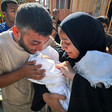Rights and Accountability 28 June 2018

Relatives of Abd al-Fatah Abu Azoum, mourn in Rafah, southern Gaza Strip, after the 17-year-old was killed by Israeli tank fire on 28 June.
APA imagesA Palestinian youth was killed and another was seriously injured after being targeted by Israeli tank fire in southern Gaza on Thursday.
The slain Palestinian was identified by Gaza’s health ministry as 17-year-old Abd al-Fatah Abu Azoum. A photo of the youth was published by Palestinian media outlets after the announcement of his death:
The Israeli military claimed that its forces had “identified two terrorists” who were crawling to the fence separating Israel and the Gaza Strip. The army said its forces “responded” with tank fire, “thwarting the infiltration attempt.”The army said that it identified Molotov cocktails at the site of the fatal incident.
The military has killed nearly 150 Palestinians in Gaza so far this year, including 21 children, nearly all along the territory’s eastern boundary with Israel.
The vast majority were fatally wounded since 30 March, which marked the launch of the Great March of Return series of protests against Israel’s decade-long siege. The demonstrations have also asserted the right of Palestinian refugees – who make up two-thirds of Gaza’s population of two million – to return to their lands on the other side of the boundary.
The United Nations High Commissioner for Human Rights has condemned Israel’s use of lethal force against Gaza protesters, saying that it may only be used as “a last resort in response to an imminent threat of death or risk of serious injury.”
The office of Zeid Ra’ad Al Hussein added that “it is difficult to see how … Molotov cocktails thrown from a significant distance at heavily protected security forces in defensive positions can be seen to constitute such threat.”
“Age doesn’t matter”
The chief prosecutor of the International Criminal Court has warned that Israel’s leaders may be liable to prosecution because of the unjustified use of lethal force against protesters in Gaza.
But that hasn’t stopped top Israeli officials from calling for indiscriminate, deadly force.
Israel’s public security minister Gilad Erdan stated last week that Palestinians launching burning kites in Gaza should be shot, even if they are children.
Erdan said that “age doesn’t matter, they’re terrorists and the danger they create must be prevented.”
Erdan has also called for the assassination of Hamas commanders because of the kites.
The launching of burning kites from Gaza has caused hundreds of fires in recent weeks, ” torching some 7,000 acres (2,800 hectares) of land and causing some $2 million in damages,” The Washington Post reported.
The kites have proven an embarrassment to one of the world’s most powerful militaries, unable to stop the disruption and damage caused by a low technology device costing only pennies to manufacture.
In recent days Palestinian groups in Gaza launched rockets towards Israel after occupation forces hit what Israeli media called “Hamas positions” and a car described as belonging to “a Hamas operative said to be involved in the launching of flaming kites into Israel.”
Tension along the Gaza-Israel boundary has not waned since 30 May, when Nickolay Mladenov, UN special coordinator for the Middle East peace process, warned that the parties were close to “the brink of war” that “no one in Gaza can afford.”
War injuries
In any event, Israel is inflicting war injuries on Gaza protesters.
A Gaza health ministry official told The Electronic Intifada that on 14 May, when Israel fatally wounded more than 60 protesters and injured thousands more, hospitals in the territory experienced a worse crisis than during any single day in the 2014 Israeli offensive on Gaza.
The World Health Organization stated this week that some 4,000 Palestinians have been wounded by live fire in Gaza since the launch of the Great March of Return protests.
Nearly 60 people, including 11 children, have had limbs amputated as a result of their injuries.
Some 350 patients are in need of limb reconstruction, requiring several surgeries and “extensive rehabilitation and treatment for up to two years,” according to WHO.
Hundreds of patients have had to be discharged from hospital early to make room for new waves of casualties during the weekly protests.
Injured Palestinians held a protest calling for adequate treatment in southern Gaza on Thursday:
Meanwhile, some 7,000 elective surgeries in Gaza have been postponed as hospitals attempt to cope with the influx of protest injuries.Israel has only granted permission to less than a quarter of those patients injured during the demonstrations who have applied to exit Gaza through Erez checkpoint for medical treatment.
The steering committee of the Great March of Return is organizing a women’s march for Tuesday, 3 July. Women around the world are being called on to hold protests in solidarity.
The protest steering committee, along with a handful of other groups in Gaza, are also calling for international supporters of Palestinian rights to print out posters of those killed during the Great March of Return and plaster them in their communities.
Israeli and international activists hung posters of slain Palestinians on the barbed wire fence along the Gaza-Israel boundary.
The website +972 reported that “It took only a few minutes for a military jeep to arrive carrying soldiers, who demanded [that] the activists take down the pictures.”
Similar actions were recently held in front of Israel’s parliament in Jerusalem and in central Tel Aviv.





